Assessing Ambisonics Sound Source Localization by Means of Virtual Reality and Gamification Tools
Abstract
1. Introduction
2. Related Work
2.1. Sound Source Localization in Ambisonics Systems
2.2. Virtual Reality and Auditory Research
2.3. The Soundlapse Project and 3D Audio Research
3. Materials and Methods
3.1. Participants
3.2. Experimental Setup
3.3. Auditory Stimuli
3.4. Experimental Task
3.5. Data Analysis
4. Results
4.1. Sound Localization First Round: Horizontal Plane
4.2. Sound Localization Second Round: Horizontal and Vertical Planes
5. Discussion
5.1. Sound Localization First Round: Horizontal Plane
5.2. Sound Localization Second Round: Horizontal and Vertical Planes
5.3. User Experience Evaluation
5.4. Hybrid Platform
6. Conclusions
Author Contributions
Funding
Institutional Review Board Statement
Informed Consent Statement
Data Availability Statement
Acknowledgments
Conflicts of Interest
References
- Barlow, C.; Michailidis, T.; Meadow, G.; Gouch, J.; Rajabally, E. Using immersive audio and vibration to enhance remote diagnosis of mechanical failure in uncrewed vessels. In Proceedings of the Audio Engineering Society Conference: 2019 AES International Conference on Immersive and Interactive Audio 2019, York, UK, 27–29 March 2019. [Google Scholar]
- Gorzynski, S.; Kaplanis, N.; Bech, S. A flexible software tool for perceptual evaluation of audio material and VR environments. In Proceedings of the Audio Engineering Society Convention 149 2020, Online, 27–30 October 2020. [Google Scholar]
- Hupke, R.; Ordner, J.; Bergner, J.; Nophut, M.; Preihs, S.; Peissig, J. Towards a Virtual Audiovisual Environment for Interactive 3D Audio Productions. In Proceedings of the Audio Engineering Society Conference: 2019 AES International Conference on Immersive and Interactive Audio 2019, York, UK, 27–29 March 2019. [Google Scholar]
- Rumsey, F. Perceptual Evaluation: Listening Strategies, Methods, and VR. J. Audio Eng. Soc. 2018, 66, 301–305. [Google Scholar]
- Boukhris, S.; Menelas, B.-A.J. Towards the Use of a Serious Game to Learn to Identify the Location of a 3D Sound in the Virtual Environment. In Proceedings of the Human-Computer Interaction. Interaction Contexts: 19th International Conference 2017, Vancouver, BC, Canada, 9–14 July 2017; pp. 35–44. [Google Scholar]
- Wu, Y.-H.; Roginska, A. Analysis and training of human sound localization behavior with VR application. In Proceedings of the Audio Engineering Society Conference: 2019 AES International Conference on Immersive and Interactive Audio 2019, York, UK, 27–29 March 2019. [Google Scholar]
- Frank, M.; Perinovic, D. Recreating a multi-loudspeaker experiment in virtual reality. In Proceedings of the Audio Engineering Society Conference: AES 2023 International Conference on Spatial and Immersive Audio 2023, Huddersfield, UK, 23–25 August 2023. [Google Scholar]
- Huisman, T.; Ahrens, A.; MacDonald, E. Ambisonics Sound Source Localization with Varying Amount of Visual Information in Virtual Reality. Front. Virtual Real. 2021, 2, 722321. [Google Scholar] [CrossRef]
- Rees-Jones, J.; Murphy, D. A Comparison Of Player Performance In A Gamified Localisation Task Between Spatial Loudspeaker Systems. In Proceedings of the 20th International Conference on Digital Audio Effects 2017, Edinburgh, Scotland, 5–9 September 2017. [Google Scholar]
- Zotter, F.; Frank, M. Springer Topics in Signal Processing Ambisonics A Practical 3D Audio Theory for Recording, Studio Production, Sound Reinforcement, and Virtual Reality; Springer Nature: New York, NY, USA, 2019. [Google Scholar]
- Frank, M.; Zotter, F.; Sontacchi, A. Producing 3D Audio in Ambisonics. In Proceedings of the Audio Engineering Society Conference: 57th International Conference: The Future of Audio Entertainment Technology–Cinema, Television and the Internet 2015, Hollywood, CA, USA, 6–8 March 2015. [Google Scholar]
- Valzolgher, C.; Alzhaler, M.; Gessa, E.; Todeschini, M.; Nieto, P.; Verdelet, G.; Salemme, R.; Gaveau, V.; Marx, M.; Truy, E.; et al. The impact of a visual spatial frame on real sound-source localization in virtual reality. Curr. Res. Behav. Sci. 2020, 1, 100003. [Google Scholar] [CrossRef]
- Native Soundfield Ambisonics Rendering in Unreal Engine|Unreal Engine 5.4 Documentation|Epic Developer Community. Available online: https://dev.epicgames.com/documentation/en-us/unreal-engine/native-soundfield-ambisonics-rendering-in-unreal-engine (accessed on 27 July 2024).
- What is Max?|Cycling ’74. Available online: https://cycling74.com/products/max (accessed on 27 July 2024).
- Aguilar, M. Implementación y Evaluación de un Diseño Sonoro en Formato 3D-Ambisonics. Undergraduate Thesis, Universidad Austral de Chile, Valdivia, Chile, 2023. [Google Scholar]
- Romigh, G.D.; Brungart, D.S.; Simpson, B.D. Free-Field Localization Performance with a Head-Tracked Virtual Auditory Display. IEEE J. Sel. Top. Signal Process. 2015, 9, 943–954. [Google Scholar] [CrossRef]
- Moraes, A.N.; Flynn, R.; Hines, A.; Murray, N. Evaluating the User in a Sound Localisation Task in a Virtual Reality Application. In Proceedings of the 2020 Twelfth International Conference on Quality of Multimedia Experience (QoMEX), Athlone, Ireland, 26–28 May 2020; IEEE: New York, NY, USA, 2020; pp. 1–6. [Google Scholar]
- Power, P.; Dunn, C.; Davies, B.; Hirst, J. Localisation of Elevated Sources in Higher-Order Ambisonics. BBC Res. Dev. White Pap. WHP 2013, 261. [Google Scholar]
- Sochaczewska, K.; Malecki, P.; Piotrowska, M. Evaluation of the Minimum Audible Angle on Horizontal Plane in 3rd order Ambisonic Spherical Playback System. In Proceedings of the 2021 Immersive and 3D Audio: From Architecture to Automotive 2021, Bologna, Italy, 8–10 September 2021. [Google Scholar]
- Rudzki, T.; Gomez-Lanzaco, I.; Stubbs, J.; Skoglund, J.; Murphy, D.T.; Kearney, G. Auditory localization in low-bitrate compressed Ambisonic scenes. Appl. Sci. 2019, 9, 2618. [Google Scholar] [CrossRef]
- Thresh, L. A Direct Comparison of Localization Performance When Using First, Third, and Fifth Ambisonics Order for Real Loudspeaker and Virtual Loudspeaker. J. Audio Eng. Soc. 2017, 9864. [Google Scholar]
- Piotrowska, M.; Bogus, P.; Pyda, G.; Malecki, P. Virtual Reality as a Tool for Investigating Auditory Perception. In Proceedings of the Audio Engineering Society 156th Convention 2024, Madrid, Spain, 15–17 June 2024. [Google Scholar]
- Ramírez, M.; Arend, J.M.; von Gablenz, P.; Liesefeld, H.R.; Pörschmann, C. Toward Sound Localization Testing in Virtual Reality to Aid in the Screening of Auditory Processing Disorders. Trends Hear. 2024, 28, 23312165241235463. [Google Scholar] [CrossRef] [PubMed]
- Otondo, F.; Rabello-Mestre, A. The Soundlapse Project Exploring Spatiotemporal Features of Wetland Soundscapes. Leonardo 2022, 55, 267–271. [Google Scholar] [CrossRef]
- Fernández, J. Diseño y Evaluación Perceptual de un Algoritmo de Epacialización Sonora en Formato Ambisonics. Undergraduate Thesis, Universidad Austral de Chile, Valdivia, Chile, 2023. [Google Scholar]
- Carpentier, T. Spat: A comprehensive toolbox for sound spatialization in Max. Ideas Sonicas 2021, 13, 12–23. [Google Scholar]
- LATE|Laboratorio de Arte y Tecnología. Available online: https://soundlapse.net/latelab/ (accessed on 27 July 2024).
- Middlebrooks, J.C. Sound localization. In Handbook of Clinical Neurology; Elsevier B.V.: Amsterdam, The Netherlands, 2015; Volume 129, pp. 99–116. [Google Scholar]
- Batschelet, E. Circular Statistics in Biology; Mathematics in Biology; Academic Press: London, UK, 1981; ISBN 0120810506. [Google Scholar]
- Mardia, K.V. A Multi-Sample Uniform Scores Test on a Circle and its Parametric Competitor. J. R. Stat. Soc. Series B Stat. Methodol. 1972, 34, 102–113. [Google Scholar] [CrossRef]
- Rayleigh, L., XII. On the resultant of a large number of vibrations of the same pitch and of arbitrary phase. Lond. Edinb. Dublin Philos. Mag. J. Sci. 1880, 10, 73–78. [Google Scholar] [CrossRef]
- Hodges, J.L. A Bivariate Sign Test. Ann. Math. Stat. 1955, 26, 523–527. [Google Scholar] [CrossRef]
- Watson, G.S. Circular Statistics in Biology. Technometrics 1982, 24, 336. [Google Scholar] [CrossRef]
- Mardia, K.V. Statistics of Directional Data. J. R. Stat. Soc. Ser. B Stat. Methodol. 1975, 37, 349–371. [Google Scholar] [CrossRef]
- Hartmann, W.M. Localization and Lateralization of Sound. In Binaural Hearing: With 93 Illustrations; Springer: Berlin/Heidelberg, Germany, 2021; pp. 9–45. [Google Scholar]
- Wightman, F.L.; Kistler, D.J. Resolution of front-back ambiguity in spatial hearing by listener and source movement. J. Acoust. Soc. Am. 1999, 105, 2841–2853. [Google Scholar] [CrossRef] [PubMed]
- Zotter, F.; Pomberger, H.; Noisternig, M. Energy-Preserving Ambisonic Decoding. Acta Acust. United Acust. 2012, 98, 37–47. [Google Scholar] [CrossRef]
- Trapeau, R.; Schönwiesner, M. The Encoding of Sound Source Elevation in the Human Auditory Cortex. J. Neurosci. 2018, 38, 3252–3264. [Google Scholar] [CrossRef]
- Lee, H. Sound Source and Loudspeaker Base Angle Dependency of the Phantom Image Elevation Effect. J. Audio Eng. Soc. 2017, 65, 733–748. [Google Scholar] [CrossRef][Green Version]
- Lee, H. Psychoacoustics of height perception in 3D audio. In 3D Audio; Routledge: New York, NY, USA, 2021; pp. 82–98. [Google Scholar]
- Stecker, G.C. Using virtual reality to assess auditory performance. Hear. J. 2019, 72, 20–22. [Google Scholar] [CrossRef] [PubMed]
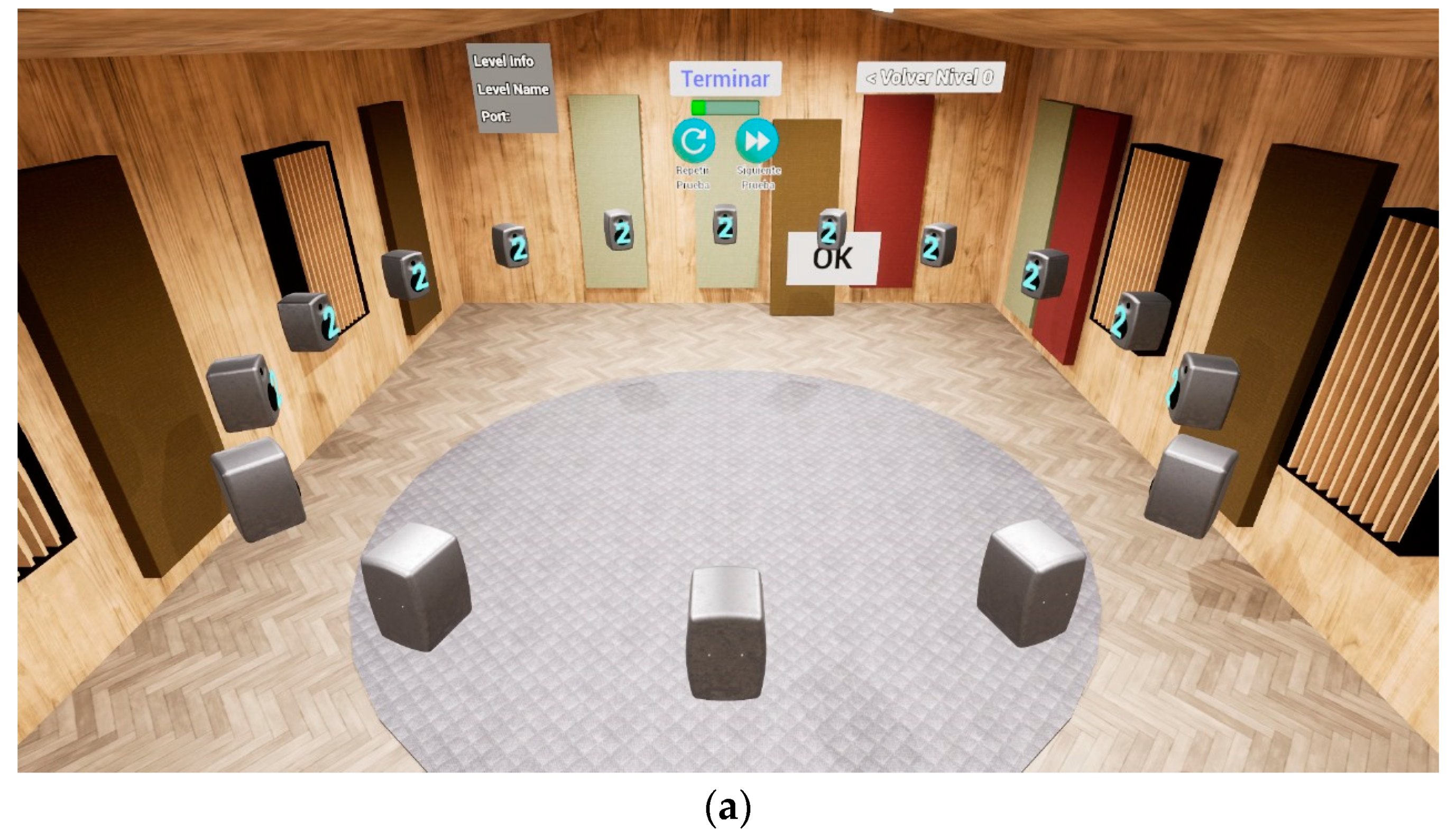


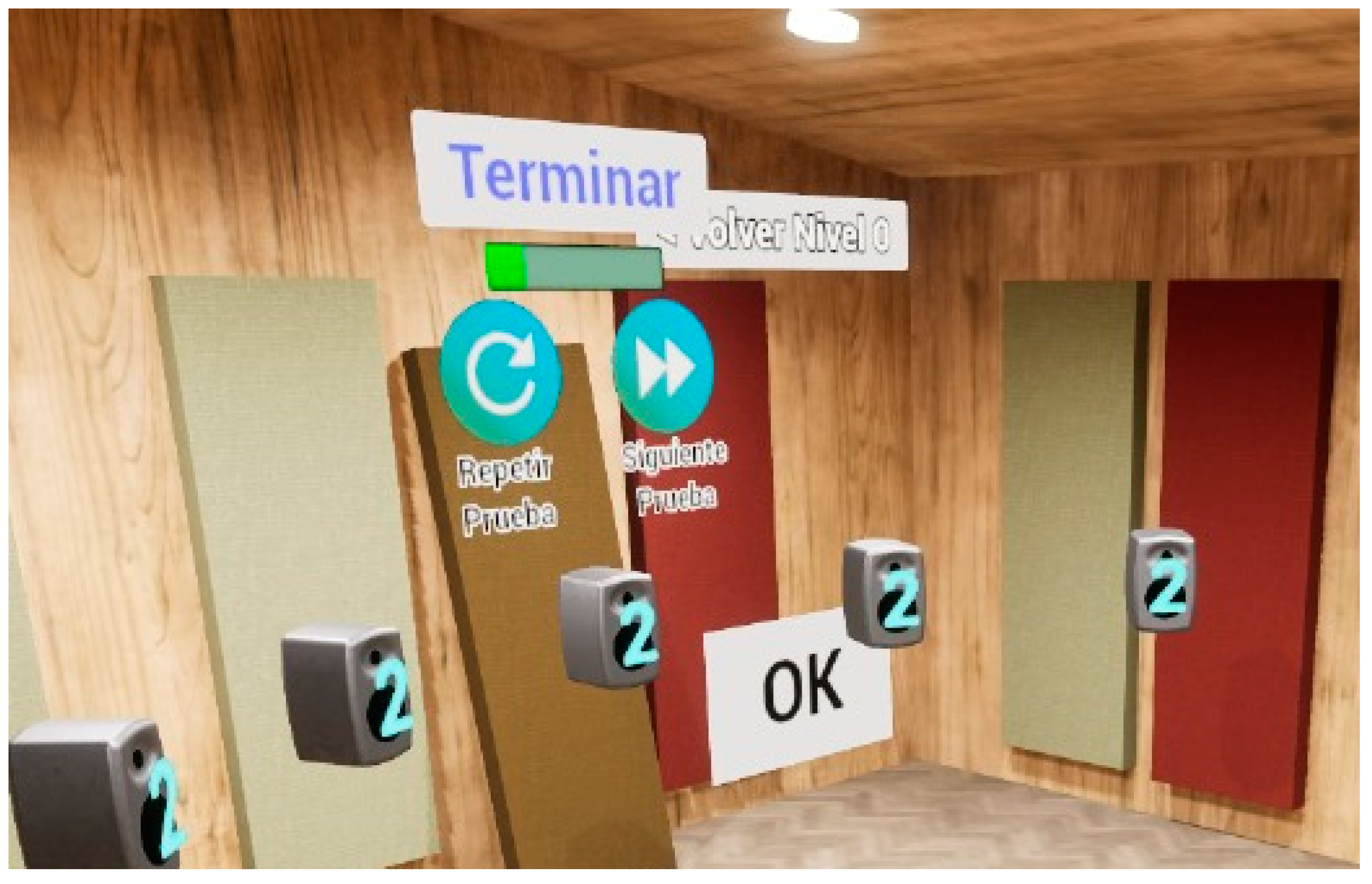

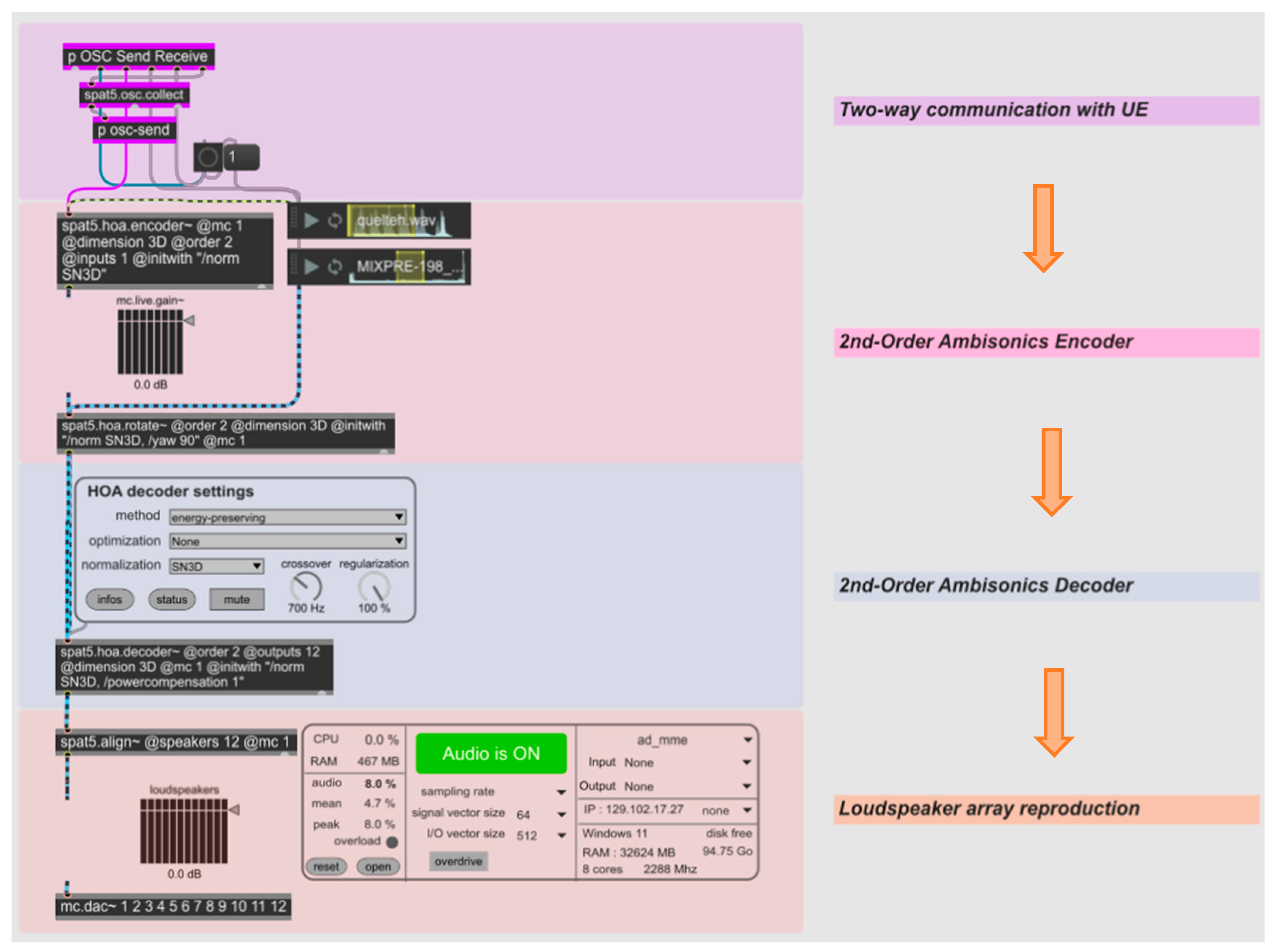
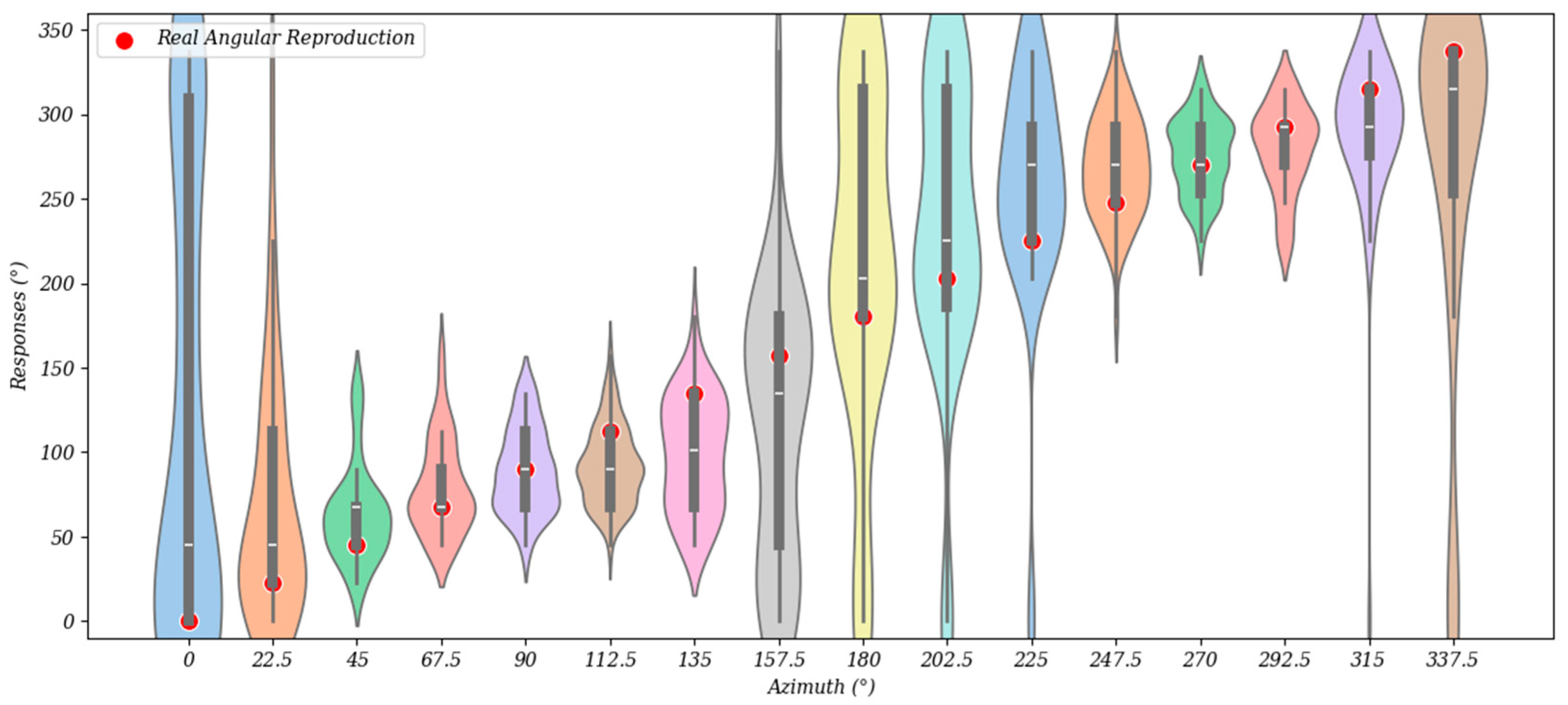
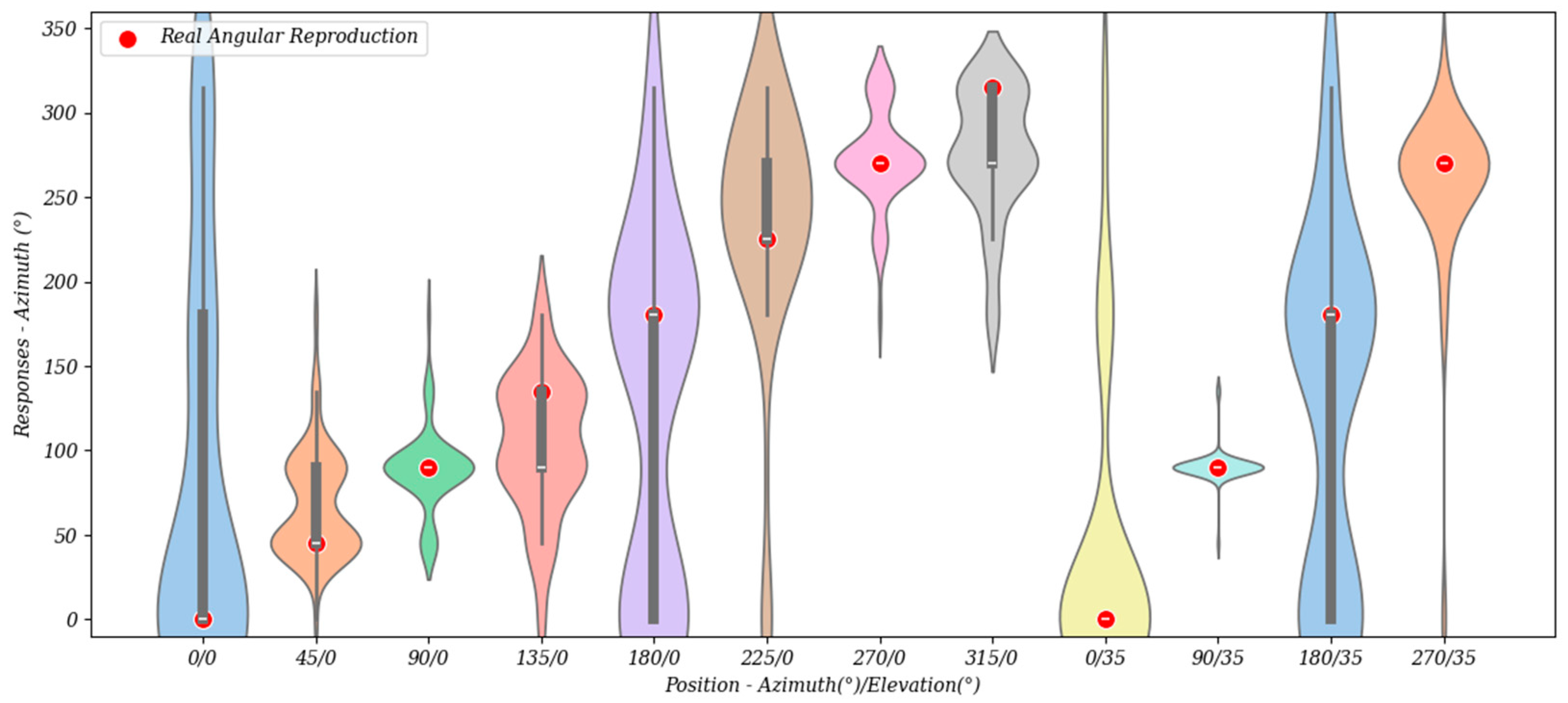
| Real Position (deg) | Perception Mean Angle (deg) | V | u | Significant (α = 0.05) |
|---|---|---|---|---|
| 0 | 354.05 | 37.38 | 6.71 | TRUE |
| 22.5 | 44.60 | 33.85 | 6.08 | TRUE |
| 45 | 61.77 | 52.60 | 9.44 | TRUE |
| 67.5 | 78.11 | 54.16 | 9.72 | TRUE |
| 90 | 88.98 | 56.48 | 10.14 | TRUE |
| 112.5 | 91.83 | 53.61 | 9.62 | TRUE |
| 135 | 99.00 | 41.99 | 7.54 | TRUE |
| 157.5 | 116.71 | 36.73 | 3.00 | TRUE |
| 180 | 253.92 | 4.585 | 0.82 | FALSE |
| 202.5 | 255.34 | 16.60 | 2.98 | TRUE |
| 225 | 269.93 | 31.58 | 5.67 | TRUE |
| 247.5 | 250.21 | 50.21 | 9.01 | TRUE |
| 270 | 275.56 | 57.13 | 10.2 | TRUE |
| 292.5 | 280.41 | 54.63 | 9.81 | TRUE |
| 315 | 297.85 | 51.93 | 9.32 | TRUE |
| 337.5 | 321.94 | 44.76 | 8.04 | TRUE |
| Comparison | Chi-Squared Statistic | p-Value |
|---|---|---|
| 0° elevation 0° vs. 35° | 1.9283 | 0.1649 |
| 90° elevation 0° vs. 35° | 13.7125 | 0.0002 |
| 180° elevation 0° vs. 35° | 0.8570 | 0.3546 |
| 270° elevation 0° vs. 35° | 8.5941 | 0.0034 |
Disclaimer/Publisher’s Note: The statements, opinions and data contained in all publications are solely those of the individual author(s) and contributor(s) and not of MDPI and/or the editor(s). MDPI and/or the editor(s) disclaim responsibility for any injury to people or property resulting from any ideas, methods, instructions or products referred to in the content. |
© 2024 by the authors. Licensee MDPI, Basel, Switzerland. This article is an open access article distributed under the terms and conditions of the Creative Commons Attribution (CC BY) license (https://creativecommons.org/licenses/by/4.0/).
Share and Cite
Medina, E.; Viveros-Muñoz, R.; Otondo, F. Assessing Ambisonics Sound Source Localization by Means of Virtual Reality and Gamification Tools. Appl. Sci. 2024, 14, 7986. https://doi.org/10.3390/app14177986
Medina E, Viveros-Muñoz R, Otondo F. Assessing Ambisonics Sound Source Localization by Means of Virtual Reality and Gamification Tools. Applied Sciences. 2024; 14(17):7986. https://doi.org/10.3390/app14177986
Chicago/Turabian StyleMedina, Esaú, Rhoddy Viveros-Muñoz, and Felipe Otondo. 2024. "Assessing Ambisonics Sound Source Localization by Means of Virtual Reality and Gamification Tools" Applied Sciences 14, no. 17: 7986. https://doi.org/10.3390/app14177986
APA StyleMedina, E., Viveros-Muñoz, R., & Otondo, F. (2024). Assessing Ambisonics Sound Source Localization by Means of Virtual Reality and Gamification Tools. Applied Sciences, 14(17), 7986. https://doi.org/10.3390/app14177986





